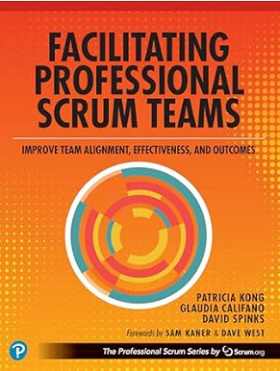| Facilitating Professional Scrum Teams (Pearson) |
|
Author: Patricia Kong, Glaudia Califano and David Spinks This book sets out to "Improvement, Effectiveness and Outcomes". How does it fare? Scrum teams aren't always havens of peace and light, powering forward to produce sparkling results. Sometimes the team members don't really understand the elements of Scrum, and end up overrunning their allocated time, not contributing and participating. This is a book that sets out solutions and suggestions for effective Scrum teams. The introduction to the book sets out a set of questions and situations that most Scrum managers will find familiar, such as 'some team members are very quiet; how can I get them to contribute more?'; and 'What do you do when stakeholders don't give feedback at the Sprint Review?' More awkward questions about handling situations where people are blaming each other, or how to get people to agree on Sprint goals and what items should be included are also in the list. The book is designed to offer ideas, tips and techniques for situations like this. After an introduction setting out why facilitation should be a complementary practice to all Scrum projects, the authors open with a chapter on facilitating alignment. As with other chapters, this starts off with an amusing description of a Scrum team doing something, in this case figuring out how they want to work together. The stories are only amusing so long as they're not sounding too much like a description of your daily working environment, of course. This first meeting involves team members making suggestions such as having stand ups, only for other team members to say that's a terrible idea, and they should have daily planks, which is then rejected by other team members who suggest..... Having given many managers nightmares, the authors then go on to suggest ideas that might help such as working agreements; and things to try such as coming up with a list of 'worst possible ideas' then discussing what the opposites are.
The second main chapter is on facilitating Scrum planning. In this case, the authors say the aim is to agree on the details of the product increment, what needs to happen to get a Sprint Goal, and how to get developers to decide what can be done. Next on the 'facilitating' list is the Daily Scrum, where the imagined version largely involves people providing status updates rather than coming up with ways to move the project towards the Sprint Goal. The authors suggest three questions to try, all framed in terms of what the team members did and will do to help meet the Sprint Goal. There's also suggestions on how to handle people turning up late or missing the meeting. The tricky topic of team dynamics is next on the agenda, specifically when meetings consist of everyone putting forward their own ideas and not taking any notice of anybody else. There's a nice and useful description of the diamond of participatory decision making - the divergent zone, the groan zone and the convergent zone, and some interesting ideas such as short periods of silent writing, and the crazy 8s idea where everyone puts down eight ideas no matter how wild. The authors discuss conflict management, and how to increase empathy (good luck there). Product Backlog Refinement is the subject of the next chapter. Topics here include how to handle stakeholders who want it all, the need to keep the user front-end in mind, and how to avoid the Scrum team becoming obsessed with estimating. A chapter on the Sprint Review comes next, with useful sections on avoiding reviews where nothing gets done, and ways to make the review more effective. A long chapter on the Sprint Retrospective looks at ways to avoid playing the blame game, how to avoid the team thinking they've improved things as much as is possible, and ways to make the retrospective fun (another case of good luck with that in my experience). The final chapter on facilitating looks at moving beyond a single Scrum team, with useful insights on how to share knowledge across teams, how to get the right people on the right team, and how to handle chaotic customer reviews. This is followed by a chapter on moving forward that sets out some common facilitation mistakes and how to avoid them. There are two appendixes, one on facilitation principles, the second on how to adapt Sprint for virtual meetings and working. Overall, this is an enjoyable book that is easy to read and makes lots of useful points and suggestions. If nothing else, it shows Scrum managers that their nightmare team isn't the only one out there driving managers to distraction and probably to drink. Highly recommended.
To be informed about new articles on I Programmer, sign up for our weekly newsletter, subscribe to the RSS feed and follow us on Twitter, Facebook or Linkedin.
|
|||
| Last Updated ( Wednesday, 04 June 2025 ) |

